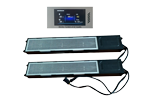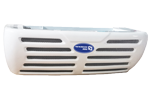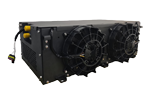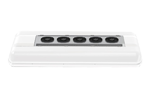There are many refrigeration methods for refrigerated truck refrigeration units. The following five are commonly used refrigeration methods:
1. Water ice and salt ice refrigeration: The water ice refrigeration device has low investment and low operating costs, but the heat absorption per unit mass of ordinary water (salt) ice is small, the cooling in the car is limited, and the melting of the salt ice will pollute the environment, Food, corroded carriages and valuable goods are damp, so water (salt) ice refrigeration is mainly used for refrigerated transportation of fish and other aquatic products.
2. Dry ice refrigeration: simple installation, low investment and operating costs, easy to use, and the goods will not be affected by moisture. The CO2 gas produced by the sublimation of dry ice can inhibit the reproduction of microorganisms, slow down fat oxidation and impair the respiration of fruits and vegetables. However, the sublimation of dry ice can easily cause frost, and excessive CO2 gas will cause difficulty in breathing and necrosis of refrigerated items such as fruits and vegetables. Moreover, the temperature in the compartment is difficult to adjust, the cost of dry ice is high, and the consumption is large, so the practical application is less.
3. Cold plate refrigeration: The device itself is heavier and bulkier, occupying a certain volume of the carriage, and the cold plate can only work for 8~15H once it is charged and cooled. Therefore, cold plate refrigeration is suitable for medium and short-distance transportation of medium and light refrigerated vehicles. In recent years, with the increasingly prominent problems of energy and environmental pollution, the application of cold plate refrigeration has developed rapidly, and it has become the second largest refrigeration after mechanical refrigeration. Way.
4. Liquid nitrogen refrigeration: the device has a simple structure, reliable operation, no noise and pollution; liquid nitrogen has a large refrigeration capacity and rapid refrigeration, and is suitable for quick freezing. The vaporization of liquid nitrogen will not cause moisture in the compartment, and nitrogen is good for food preservation and prevention of dry consumption. In addition, the liquid nitrogen refrigeration temperature is precise (plus or minus two degrees). However, the cost of liquid nitrogen is high and it needs to be filled frequently, so the promotion is limited. Similarly, other low-temperature vaporized liquid gases can also be used as refrigerants, such as liquid carbon dioxide.
5. Mechanical refrigeration: Mechanical refrigeration methods include vapor compression, absorption, and vapor injection. At present, the vapor compression type is the most widely used. Compression refrigeration unit is mainly composed of compressor, condenser, throttle valve (or expansion valve) and evaporator.









.png)






